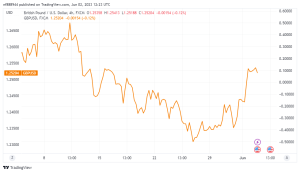GBPUSD remains over 1.2500.
On Friday, GBPUSD was trading flat in a narrow band above 1.2500, with market participants avoiding huge wagers. Ahead of the US’s all-important May jobs data.
The ongoing selling pressure on the US Dollar (USD) fueled the GBPUSD rise on Thursday. With the pair reaching its highest level in three weeks above 1.2550. The large lower revision to first-quarter Unit Labor Costs data, from 6.3% to 4.2%, spurred a new leg of USD selling in the American session by feeding into dovish Federal Reserve (Fed) views.
Following a poor US employment data, the pound sterling might reach 1.2580.
The US Bureau of Labor Statistics Nonfarm Payrolls (NFP) are predicted to rise by 190,000 in May, down from 253,000 in April. According to the monthly report. Average hourly earnings are expected to increase 4.4% year on year. mirroring the previous month’s report.
If NFP growth falls below 150,000. investors may see this as a reaffirmation of the Fed‘s policy tightening halt in June, forcing the USD to remain under pressure. Wage inflation that remains unchanged or falls unexpectedly should have a comparable negative impact on the USD’s value.
If the labor market data reveals a healthy rise in payrolls of about 250,000. Market players may change their view and begin pricing in a larger possibility for another 25 basis points. The Fed will raise interest rates at its next meeting. In such case, GBPUSD might fall ahead of the weekend.
GBPUSD Technical Outlook
The four-hour chart’s Relative Strength Index (RSI) indicator remains well above 60. And the 20-period SMA made a bullish cross with the 100-period SMA. Indicating the accumulation of upside momentum.

Interim resistance for GBPUSD is at 1.2550 (daily high, static level). Followed by 1.2580 (static level) and 1.2650 (starting point of the latest downturn).
On the downside, 1.2520 (Fibonacci 23.6% retracement) serves as an immediate support level ahead of 1.2500 (psychological threshold) and 1.2480 (200-period SMA, Fibonacci 50% retracement).









